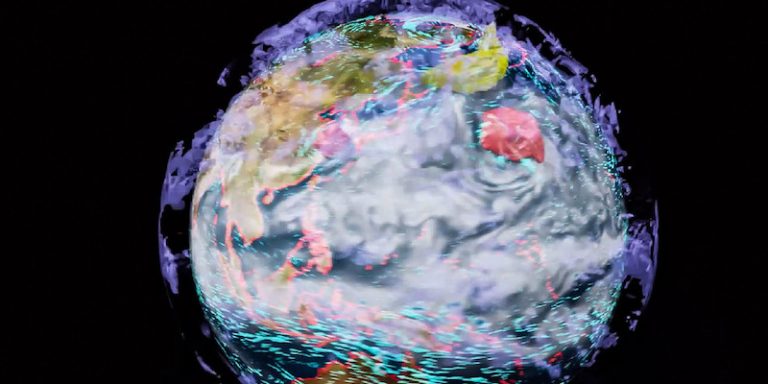
During his keynote address at the GPU Technology Conference (GTC), NVIDIA CEO Jensen Huang announced plans to begin building a supercomputer, Earth 2 (E2), a digital twin of the Earth, capable of predicting climate change by leveraging computational speeds powered by artificial intelligence. It will be built with NVIDIA Omniverse, the company’s scalable, multi-GPU, real-time reference development platform for 3D simulation.
“It will run the AI physics created by Modulus at a million times the speed in Omniverse. All the technologies we have invented so far are necessary to make E2 possible. I can’t imagine a bigger and more important news.”
By June 2021, NVIDIA had launched Cambridge-1, a $100 million supercomputer for healthcare researchers in the UK, with participation from GSK and AstraZeneca. Earth 2 is the next step.
The improvements possible with Earth’s digital twins
- Climate change
Earth 2, the world’s most powerful supercomputer, will be dedicated to simulating climate models that predict the impacts of global warming on the world. Understanding these changes over time could help mitigate these changes. But, according to NVIDIA, long-term climate simulation is more difficult than weather simulation because it must model the physics of the Earth’s atmosphere, oceans and waters, ice, land, human activities and all their interactions. In addition, simulation resolutions of one to ten metres are required to incorporate effects such as lower atmospheric clouds that reflect solar radiation back to space. The company is using its new Modulus Framework for the development of machine learning models in physics. Progress must be made quickly, given the rapidity with which the Earth’s climate is changing.
- Species recognition
Albert Bifet, director at the University of Waikato’s AI Institute, and professor of Big Data at Institut Telecom Paris, is leading a data science program using an NVIDIA DGX A100 to build deep learning models for species recognition. He is developing a new machine learning library in Python called River for online/streaming machine learning.
- Accelerated drug discovery
Researchers at NVIDIA, CalTech and start-up Entos created OrbNet, which blends machine learning and physics, enabling orders of magnitude faster molecular simulations. Entos combines machine learning and automated chemistry, a revolution in the design of small molecule therapeutics. Entos is capable of accelerating its drug discovery simulations by 1,000 times, doing in three hours what would have taken over three months.
- Manufacturing 4.0
Researchers are building digital twins of cities and factories. Dr Johan Barthelemy, director of the Digital Living Lab at the University of Wollongong, for example, is working on a computer vision application for smart waterways that detects rainwater blockages in real time. Another project, currently being rolled out in several cities, is AI camera software that detects and reports violence on Sydney trains through aggressive position modelling.
An AIoT platform for remote monitoring of the Antarctic land environment is also in the works. Built around a state-of-the-art NVIDIA Jetson Xavier NX computer, the platform will monitor the evolution of moss beds, their health being an early indicator of the impact of climate change. The data collected will feed into hydrology and microclimate models developed by the Securing Antarctica’s Environmental Future research community.
- Advances in SARS-CoV-2
NVIDIA researchers and 14 partners have developed a platform to explore the composition, structure and dynamics of aerosols and aerosolized viruses at the atomic level. They were able to make a series of groundbreaking discoveries regarding the Delta variant of SARS-CoV-2. The full impact of the project has not yet been realized, but there could be significant advances in the capabilities of multiscale computational microscopy of experimental methods.
- Medical imaging, therapeutic robots and natural language depression detection
In 2020, Dr. Ekapol Chuangsuwanich and his team developed PYLON, which learns the precise location of an object at the pixel level from a simple image-level annotation. This architecture is being deployed in hospitals in Thailand to provide rapid assessments of the severity of COVID-19 and to facilitate TB screening in high-risk communities.
They are also working on robots with automatic speech recognition for therapeutic use, such as to assist in speech therapy, and a robot with a depression detection function. These projects were created using the NVIDIA NeMo framework and deployed on NVIDIA Jetson Nano devices.
The Quantum-2 platform, a new supercomputer architecture
Supercomputers are typically built from large networks of Linux-based servers, linked together by high-speed interconnects. As cloud providers begin to offer supercomputing services, NVIDIA’s Quantum-2 platform, available now, offers a significant shift in supercomputing architecture. For Jensen Huang:
“Quantum-2 is the first networking platform to offer the performance of a supercomputer and the shareability of cloud computing,” said Huang. This has never been possible before. Until Quantum-2, you either got high bare metal performance or secure multi-tenancy, but never both. With Quantum-2, your precious supercomputer will be cloud-native and much better utilized.”
Back in August 2020, NVIDIA inserted a virtual line from its CEO in a keynote speech. The company revealed in a blog post that its CEO Jensen Huang did not give the keynote presentation at the company’s GTC conference in April. At least part of it was actually led by a virtual replica of Huang, created by scanning Huang and then animating him with AI. Huang’s kitchen, which has become Nvidia’s place to talk to customers and investors since the pandemic began, was also entirely computer-generated.
Translated from Focus sur E2, le projet de jumeau numérique de la Terre développé par NVIDIA et sur ses applications









